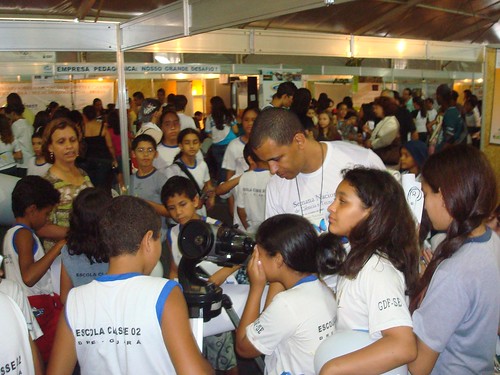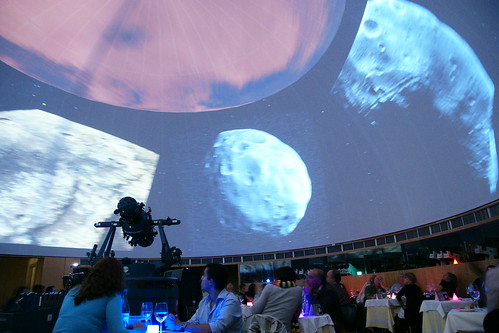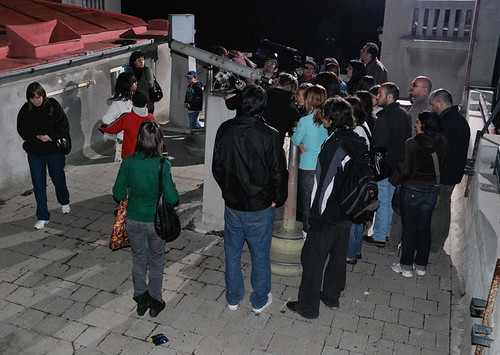IYA2009 Updates
Clockwork Skies digital planetarium show free to download and use
5 March 2010
Participants of the Spring 2010 Blender Production Workshop were set a challenging task: develop their own skills by creating an immersive fulldome planetarium show under very strict time limits. The result is the entertaining yet informative show Clockwork Skies.
This show was built by four students, in eight hours, after only 16 hours of instruction. The show and its source are available to the world under the Creative Commons Attribution License, and the script is also online.
For more information, as well as to see the show and obtain the files, please visit: http://community.weber.edu/planetarium/ceres/default.html
IYA2009 Galilean Nights award winners announced!
4 March 2010
The IYA2009 Cornerstone project Galilean Nights ran during October 2009 and saw thousands of individuals and organisations host a wide range of events to popularise astronomy and highlight the importance of Galileo's legacy. Now that event reports have been collated the Galilean Nights awards can be announced. There are six categories, each with a winner and two highly commended entries. Selecting the winners was a challenging task as the quality of all of the events was extremely high. It was particularly difficult to select only three for the Community Outreach award as all events did great work in engaging with their local communities in different ways, there could easily have been many more added to the Highly Commended list.
Congratulations go, not only to all of the winners and the highly commended entries but to everybody involved in Galilean Nights. Every single event played an important role in bringing astronomy to people all around the world. It was this combined effort that made Galilean Nights a huge success and one of the long-standing memories of IYA2009, with many organisers planning to turn their activities into recurring events.
The Galilean Nights Awards are kindly supported by EurAstro (http://eurastro.de/)
Outstanding Galilean Nights Event
Winner: "Galilean Nights Festival at Targoviste" run by SARM - The Romanian Society for Meteors and Astronomy. This truly spectacular event attracted around 3200 attendees. The organisers really went above and beyond by arranging for a press conference and a special live TV broadcast. Congratulations! http://www.galileannights.org/events/reports/gn1,185.pdf
Highly commended: AstroDnepr sidewalk astronomy event at the Festival'ny Prichal, Ukraine. Organisation for this event began in August, and an impressive 14 institutions collaborated to make it a reality. Lots of effort was put into involving children in the astronomical fun. Galilean Nights was used a springboard, as many initiatives have continued.
http://www.galileannights.org/events/reports/gn34.pdf
Highly commended: Galilean Nights at the Ghana Planetarium run by Ghana Planetarium and the Ghana Astronomy and Observation Association. This special day enthused students from major institutions and gave members of the public the opportunity to view the skies as Galileo did 400 years ago. There were also sell-out shows in West Africa's only digital planetarium.
http://www.galileannights.org/events/reports/gn809.pdf
Largest number of registered events held by a single group
Winner: Centro de Estudos Astronômicos de Alagoas – CEAAL, Brazil. 29 events. Centro de Estudos Astronomicor de Alagoas really embraced Galilean Nights and ran outreach activities of all varieties. From putting on astrophotography exhibitions in major shopping malls and at the university, public observing sessions all over the city, to travelling with a mobile planetarium to more remote locations. Through their activities CEAAL reached tens of thousands of people. http://www.galileannights.org/events/event_country_brazil.html#gn664
Highly commended: Universidade Federal de Alfenas - Campus Poços de Caldas, Brazil. 11 events. The Universidade Federal de Alfenas put on several different events to introduce students and the public to the joys of astronomy. Using many different activities, from night sky observing to theatre shows, there was something to capture the attention of everybody. http://www.galileannights.org/events/event_country_brazil.html#gn775
Highly commended: NUCLIO - Núcleo Interactivo de Astronomia, Portugal, 9 events. The Núcleo Interactivo de Astronomia filled all three days of Galilean Nights with activities. They held observing sessions, astronomy workshops, daytime observing of the Sun and public lectures on astronomy. They even ran learning sessions for teachers with practical demonstrations on how to make astronomy and science learning fun. http://www.galileannights.org/events/event_country_portugal.html#gn896
Highest attendance at a single registered event

Winner: “Exposição de Telescópios” run by Clube de Astronomia de Brasília, Brazil. More than16 500 people observed Jupiter and its moons with their own eyes over the course of seven days. http://www.galileannights.org/events/reports/gn835.pdf
Highly commended: “Cosmic Landscape”, Brazil. This public exhibition was held at the biggest shopping mall in Maceió (Brazil), and was swamped with 15,000 attendees. http://www.galileannights.org/events/reports/gn665.pdf
Highly commended: Sidewalk astronomy night around Bangalore, India. Run by the Bangalore Astronomical Society in India, this non-stop astrofest lasted for 30 consecutive nights and was experienced by 10,277 people. http://www.galileannights.org/events/reports/gn1,237.pdf
Community outreach
Winner: Centro de Estudos Astronômicos de Alagoas, Brazil. This group travelled in a caravan through five cities in the State of Alagoas in Brazil to reach small communities with their Galilean Nights activities. http://www.galileannights.org/events/event_country_brazil.html#gn665
Highly commended: The Biggest Astrophoto Exhibition held in Erbil, Iraq. Many attendees stated that seeing Jupiter through a telescope made this day the most wonderful and interesting of their lives! http://www.galileannights.org/events/reports/gn1,268.pdf
Highly commended: "I saw the Moon", Afghanistan. Run by the Afghanistan Astronomy Association (AAA), around 70 people braved the cold weather to see the Moon for the first time through a telescope. Attendees were presented with remembrance cards to mark the occasion. http://www.galileannights.org/events/reports/gn924.pdf
Most innovative event

Winner: Dinner on Mars, Portugal. Run by Portugal's Navegar Foundation, this highly creative event saw diners sample dishes such as “Olympus Mons Duck” and “Valles Marineris Monkfish” whilst watching an astronomical tour projected onto a planetarium dome. Delicious! http://www.galileannights.org/events/reports/gn181.pdf
Highly commended: An Evening in Tuscany Dinner & Dance, Canada. Organised by the Vancouver Tuscany Cultural Society in Canada, this Galilean Nights event featured astronomical artwork, a Galileo actor (and two renaissance ladies), and scientific experiments... as well as dinner and dancing, of course. http://www.galileannights.org/events/reports/gn296.pdf
Highly commended: Galilean Nights in Second Life. The virtual world of Second Life enjoyed astronomical fun thanks to interactive models of Jupiter and its moons, realistic telescopic views, and a planetarium show staged in a virtual reproduction of Galileo's villa. ttp://www.galileannights.org/events/reports/gn1,202.pdf
Best "Plan B"

Winner: The Galilean Night with hot tea and a journey to Jupiter, Romania Over six hours the Asociatia Astroclubul Bucuresti, Romania, hosted 300 visitors, prepared 250 cups of tea, and made six presentations. The event was broadcast by three major TV stations, four radio stations and nine websites, and was featured on the Galilean Nights LiveBlog. Not bad for a back-up plan thought up in two days because of bad weather! http://www.galileannights.org/events/reports/gn73.pdf
Highly commended: Reto Mexico 2009 Biznaga Teatro theatre show, Mexico Run by Departamento de Astronomia, Universidad de Guanajuato, Mexico, rain prevented telescopic observations so instead a play with 20 actors was presented, followed by a public talk by a professional astronomer. http://www.galileannights.org/events/reports/gn191.pdf
Highly commended: Northern Michigan Star Party, USA Mary Stewart Adams of Emmet County, USA, had the bright idea of featuring a live audio-visual presentation for those unable to attend local events. Using the online international astronomy community, Astronomy.FM, there was a slideshow with narration and a chatroom Q&A. http://www.galileannights.org/events/reports/gn1,194.pdf
She is an Astronomer conference
4 March 2010
Celebrating success and seeking solutions
Date: 22 and 23 April 2010
Venue: Royal Astronomical Society, Burlington House, Piccadilly, London, UK
To celebrate the ending of the IYA2009 Cornerstone Project 'She is an Astronomer', a conference is being held in London. The conference will be opened by Prof Jocelyn Bell Burnell.
There will be talks and posters on:
- pioneering women in astronomy,
- women and their science,
- female astronomers from around the world,
- careers,
- work-life balance,
- mentoring,
- imposter syndrome,
- correcting gender myopia,
- statistics and surveys,
- IYA2009 and beyond,
- running a blog,
- web forum
- and much, much more.
One outcome of the meeting will be a list of suggestions for supporting and encouraging women in astronomy in support of the IAU Resolution passed at the IAU General Assembly in August 2009. Presentations (talks and posters) will be published on the She is an Astronomer website. If you would like to attend the meeting, please register on-line, indicating if you would like to give a talk or present a poster. Space is limited, so please register.
The deadline for registration has been extended to 15 March.
The cost will be £50, to cover refreshments and lunches.
For more information and registration see:
http://www.sheisanastronomer.org/index.php/Conference
Helen Walker
Co-Chair of She is an Astronomer
Chair of Organising Committee
Careers in Astronomy
3 March 2010

The IAU has published a new theme about Careers in Astronomy: http://www.iau.org/public/careers/
Bareket Observatory brings cutting-edge science education within reach
2 March 2010
Bareket Observatory (Israel) introduces teachers and students from around the country to other colleagues from all over the globe and provides them with the scaffolding to perform research projects in their classroom. Students are participating at the projects by using the observatory's on-line activities and completing observations on its state of the art remote internet telescope, analysing the data and interpreting their results.
The ASTRO-EDU programme's core actions give an opportunity to anyone who has an interest in the night sky and wishes to have fun learning about the Universe in a scientific manner. It is "research-based" in the sense that it integrates scientific research with education, globally speaking.
In order to achieve a comprehensive coverage for the project it was decided to start an initiative to create a large educational database for students and teachers. Over the following months a new state-of-the-art educational website, including lesson plans, online activities, video training, a CCD library, and much more will be released. A goal is to translate all materials into Arabic to make it more accessible to the Israeli population.
For more information about the Bareket Observatory, please see their official website: http://www.bareket-astro.com/
Galileo Teacher Training Program: deadline extended
1 March 2010
The Galileo Teacher Training Program has decided to extend the deadline of the call for proposals to 25 March 2010.
More information:http://www.astronomy2009.org/news/updates/768/
First Light: Photography & Astronomy exhibition
1 March 2010
Since the late 19th Century, astronomers have been exploring the limits of human perception by way of photography. Those limits were surpassed once and for all with the arrival of space travel and the satellite. In photographs, the seemingly infinite size of the Universe is reduced to human proportions, yet it remains an elusive idea. Partly for that reason, astronomy has had a long history of popularising research. In the past, original photographs appeared in illustrated non-specialist publications on astronomy. Nowadays the information that astronomers gather for their research is translated into spectacular and almost painterly images that reach us via newspapers, magazines, television and the internet.
First Light: Photography & Astronomy will be held at the Huis Marseille Museum for Photography in Amsterdam between 6 March and 30 May 2010. It will comprise a first-time combination of unique historical astronomy photographs, from Dutch collections, and present-day images made by famous telescopes and space probes such as ESO, Hubble and Cassini.
Organised in collaboration with the Stichting Academisch Erfgoed (SAE) and the Nederlandse Onderzoekschool voor Astronomie (NOVA).
For more information, please see: http://www.huismarseille.nl/
Space Education and Outreach Symposium call for abstracts
1 March 2010
Space Education and Outreach Symposium at this year’s International Astronautical Congress is taking place in Prague at the end of September. This symposium deals with activities, methods and techniques for formal and informal space education at different educational levels, space outreach to the general public, space workforce development, etc. Each of the sessions in the symposium features an invited key note speaker followed by presentation of selected papers. Symposium sessions may also include panel discussions.
When submitting abstracts for consideration, please note that:
- Papers should have clear education or outreach content – purely technical details of projects, even if carried out in an educational context, will not usually qualify.
- Papers reporting on programmes/activities that have already taken place will usually be received more favourably than those dealing with concepts and plans for the future.
- More weight will usually be given to papers that clearly identify target groups, benefits, lessons-learned, good practice and that include measures of critical assessment.
You can find the full IAC call for papers and details of how to upload abstracts at: http://www.iac2010.cz/en/call-for-abstracts
The deadline for submission is this Friday, 5 March.
Details of the symposium and its sessions:
E1.1. LIFT OFF - PRIMARY AND SECONDARY SPACE EDUCATION
This session will focus on all aspects of primary and secondary (K-12) space education.
E1.2. ON TRACK - UNDERGRADUATE AND POSTGRADUATE SPACE EDUCATION
This session will focus on all aspects of undergraduate and (post)graduate space education.
E1.3. CALLING PLANET EARTH - SPACE OUTREACH TO THE GENERAL PUBLIC
This session will focus on activities that aim to promote awareness and understanding of space in the general public.
E1.4.NEW WORLDS - INNOVATIVE SPACE EDUCATION AND OUTREACH
This session will focus on novel and non-standard methods of space education and outreach in non-traditional areas and to non-traditional target groups.
E1.5. TO BOLDLY GO - SPACE STATION EDUCATION AND OUTREACH
This cross-cutting session will focus on education and outreach activities that leverage the inspirational value of the International Space Station and which aim to prepare today's students and future generations to be actively involved in turning space exploration visions into a sustainable endeavour.
E1.6/E5.4 WATER AND SPACE: SOCIETAL, EDUCATIONAL AND CULTURAL ASPECTS
(Joint session with the IAA Commission VI, co-sponsored by ITACCUS). This joint inter-disciplinary session will explore the societal and cultural contexts of water as they are related to space. Possible topics include: political and economic issues; how the crises affecting oceans impact society; how the discoveries of water on the Moon and Mars impact both the human condition on Earth and human space exploration; the way the arts, popular culture and entertainment engage with cultural issues related to water, remote sensing co-ordination and public access; educational programmes relating to water from space and water in space, etc.
E1.7. SPACE WORKFORCE DEVELOPEMENT – CHALLENGES AND OPPORTUNITIES
This session will focus on challenges, opportunities and innovative solutions for attracting, improving and retaining the future and current global space workforce.
March issue of Practical Astronomy magazine is available to download for free
28 February 2010

Practical Astronomy is a new magazine, distributed for free by means of digital download from the internet. The magazine is published by Structure Ltd (a UK registered company) in PDF format, making it readable and printable by most computers in the World. The contents of the latest issue are as follows:
- LOW COST ASTROPHOTOGRAPHY: Afocal imaging with a digital camera
- LUNAR FEATURE TO OBSERVE: The “Moon Maiden”
- READERS' IMAGE GALLERY: Your astronomy photos and images
- REMOTE TELESCOPE PROJECT (PART 1): Control from afar (read part 2 in the Members’ Area)
- ASTRONOMY RECIPE OF THE MONTH: Asterism chocolate truffles
- BEGINNERS’ GUIDE TO IMAGING (PART 2): Hugh’s journey continues… this time, the Moon
- SAGAS – AN INTRODUCTION: The Southern Area of Astronomical Societies
- SKY VIEW – MARCH: Maps of the Night Sky – looking East, South, West, North
- OBSERVERS’ DELIGHTS: Special observing sights not to miss this month
Download the issue here: http://practicalastronomy.com/
Help to collect stories about the stars
27 February 2010
The project "The Sky of our grand parents" involves the general public, in particular ancient people and rural and isolated populations, in collecting traditional stories in order to discover old myths and ancient knowledge of astronomy before they become lost.
The Science Museum of the University of Coimbra is looking for partners who are willing to collect texts and stories all over the world and make them available to the public.
Contributions in Portuguese or English will be included in this website, and a link to websites with contributions in other languages will be included as well.
For more information, please see: http://www.museudaciencia.pt/index.php?iAction=Actividades&iArea=3&iId=107
Search IYA2009 Updates

National Nodes: 148
Organisational Nodes: 40
Organisational Associates:33
National Websites: 111
Cornerstone Projects: 12
Special Task Groups: 11
Special Projects:16
Official Products:8
Media Partners:22


